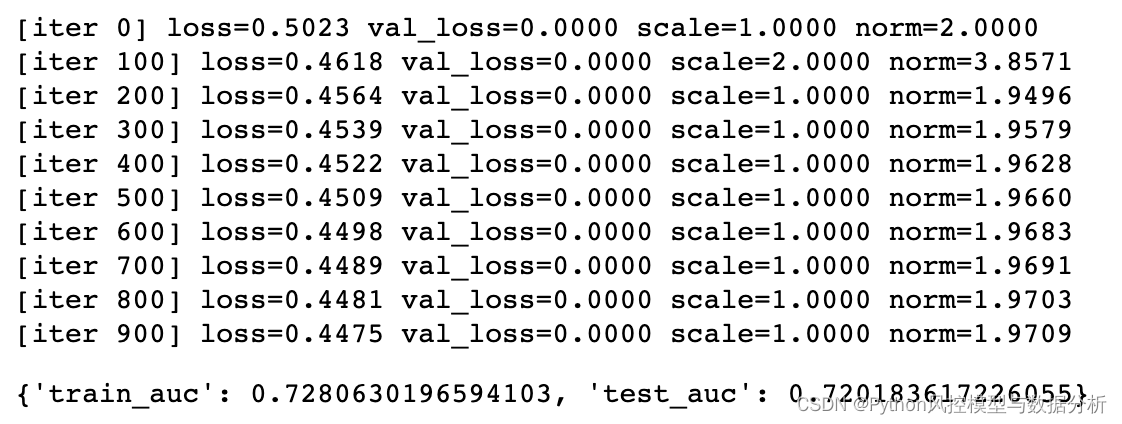目录
NGBoost是继xgboost、lightGBM、catboost之后boosting家族的新成员,拥有更高的精度、但是由于计算复杂度高导致训练和推理速度更慢。
官方文档:User Guide

论文:https://arxiv.org/abs/1910.03225
一、模型介绍
NGBoost(Natural Gradient Boosting)是一种概率预测模型,它结合了梯度提升树和自然梯度下降的思想。NGBoost 的主要目标是通过预测目标变量的分布来提高预测精度,而不仅仅是预测一个点估计值(这里更多是针对回归问题,分类问题其他模型也可以支持)。
NGBoost 使用自然梯度下降来更新模型参数,可以减少训练过程中的振荡和收敛时间。自然梯度下降是梯度下降的变体,它使用 Fisher 信息矩阵来归一化梯度方向,以便在不同参数空间中进行更准确的更新。这种方法可以使得 NGBoost 更加鲁棒,并且具有更好的收敛性能。
二、参数详解
ngboost超参数的数量并不多,远低于catboost(如需直接使用,可将 :替换为 # )
ngb_params={
'Dist':k_categorical(2), : 预测值y的分布,取值k_categorical, Bernoulli,Normal,Exponential等
'Score':LogScore, : 损失函数,取值LogScore, CRPScore
'Base':default_tree_learner, : 基学习器,取值default_tree_learner、DecisionTreeRegressor(criterion='friedman_mse', max_depth=4)
'natural_gradient':True, : 自然梯度 or 常规梯度
'n_estimators':1000, : 迭代次数
'learning_rate':0.01, : 学习速率
'minibatch_frac':1.0, : 行采样
'col_sample':1.0, : 列采样
'verbose':True,
'verbose_eval':100,
'tol':0.0001, : 迭代过程中损失函数阈值,当损失函数的变化小于tol时,训练过程将停止
'random_state':1,
}三、实战
1、使用前文的数据(ps:含catboost相关参数解释)
catboost参数详解及实战(强推)_Python风控模型与数据分析的博客-CSDN博客
# 1、导包
import re
import os
import pandas as pd
import numpy as np
import warnings
warnings.filterwarnings('ignore')
import sklearn
from sklearn.model_selection import train_test_split
from sklearn.metrics import roc_curve,roc_auc_score
import matplotlib.pyplot as plt
import gc
from bayes_opt import BayesianOptimization
from catboost import Pool, cv
import ngboost
from ngboost import NGBClassifier
from ngboost.learners import default_tree_learner
from sklearn.tree import DecisionTreeClassifier,DecisionTreeRegressor
from ngboost.distns import k_categorical, Bernoulli,Normal,Exponential
from ngboost.scores import LogScore, CRPScore
# 2、数据读取
df=pd.read_csv('E:/train.csv',engine='python').head(80000)
print(df.shape)
df.head()
# 3、预处理
df_copy['employmentLength']=df_copy['employmentLength'].replace(' years','')
dic={'< 1':0,'10+':20}
df_copy['employmentLength']=df_copy['employmentLength'].map(dic).astype('float')
# 4、特征分组
float_col=list(df_copy.select_dtypes(exclude=['string','object']).drop(['id','isDefault'],axis=1).columns).copy()
cate_col=['grade', 'subGrade']
all_fea=float_col+cate_col
2、catboost建模
设置迭代次数1000、学习速率0.01、行采样列采样均为100%,最终效果train、test的auc分别为0.72、0.718
catboost_params={
'loss_function': 'Logloss',
'custom_loss': 'AUC',
'eval_metric': 'AUC',
'iterations': 1000,
'learning_rate': 0.01,
'random_seed': 123,
'l2_leaf_reg': 5,
'bootstrap_type': 'Bernoulli',
'subsample': 1,
'sampling_frequency': 'PerTree',
'use_best_model': True,
'best_model_min_trees': 50,
'depth': 4,
'grow_policy': 'SymmetricTree',
'min_data_in_leaf': 500,
'one_hot_max_size': 4,
'rsm': 1,
'nan_mode': 'Max',
'input_borders': None,
'boosting_type': 'Ordered',
'max_ctr_complexity': 2,
'logging_level': 'Verbose',
'metric_period': 1,
'early_stopping_rounds': 20,
'border_count': 254,
'feature_border_type': 'GreedyLogSum'
}
def catboost_model(df,y_name,params,cate_col=[]):
x_train,x_test, y_train, y_test =train_test_split(df.drop(y_name,axis=1),df[y_name],test_size=0.2, random_state=123)
model = CatBoostClassifier(**params)
model.fit(x_train, y_train,eval_set=[(x_train, y_train),(x_test,y_test)],cat_features=cate_col)
train_pred = [pred[1] for pred in model.predict_proba(x_train)]
train_auc= roc_auc_score(list(y_train),train_pred)
test_pred = [pred[1] for pred in model.predict_proba(x_test)]
test_auc= roc_auc_score(list(y_test),test_pred)
result={
'train_auc':train_auc,
'test_auc':test_auc,
}
return model,result
model,model_result=catboost_model(df_copy[all_fea+['isDefault']],'isDefault',params,cate_col)
model_result![]()
3、ngboost建模
注意点:
(1)不支持类别型变量入模,需要自行编码
(2)不支持缺失数据入模,需要自行填充
(3)由于模型复杂度高,训练、推理速度减慢,不过通用参数效果依然很好
控制参数与catboost相近,为方便此处仅使用数值型变量进行拟合评估。最终效果train、test的auc分别为0.728、0.72,这里实际上还有小部分信息损失,包括类别型变量信息、缺失值填充导致的损失,模型效果依然坚挺!
ngb_params={
'Dist':k_categorical(2), # 预测值y的分布,取值k_categorical, Bernoulli,Normal,Exponential等
'Score':LogScore, # 损失函数,取值LogScore, CRPScore
'Base':default_tree_learner, # 基学习器、类似于子树,取值default_tree_learner、DecisionTreeRegressor(criterion='friedman_mse', max_depth=4)
'natural_gradient':True, # 自然梯度 or 常规梯度
'n_estimators':1000, # 迭代次数
'learning_rate':0.01, # 学习速率
'minibatch_frac':1.0, # 行采样
'col_sample':1.0, # 列采样
'verbose':True,
'verbose_eval':100,
'tol':0.0001, # 迭代过程中损失函数阈值,当损失函数的变化小于tol时,训练过程将停止
'random_state':1,
}
def ngboost_model(df,y_name,fea_list,params):
x_train,x_test, y_train, y_test =train_test_split(df[fea_list],df[y_name],test_size=0.2, random_state=123)
model = NGBClassifier(**params)
model.fit(x_train, y_train)
train_pred = model.predict_proba(x_train)[:,1]
train_auc= roc_auc_score(list(y_train),train_pred)
test_pred = model.predict_proba(x_test)[:,1]
test_auc= roc_auc_score(list(y_test),test_pred)
result={
'train_auc':train_auc,
'test_auc':test_auc,
}
return model,result
ngboost_model,model_result=ngboost_model(df_copy.fillna(-1),'isDefault',float_col,ngb_params)
model_result
感兴趣的同学可以去尝试一下,ngboost的回归、分类模型效果都很好,横向对比xgboost、lightgbm、catboost。
精华部分
关注威信公众号Python风控模型与数据分析,获取更多Python、机器学习、深度学习、风控知识